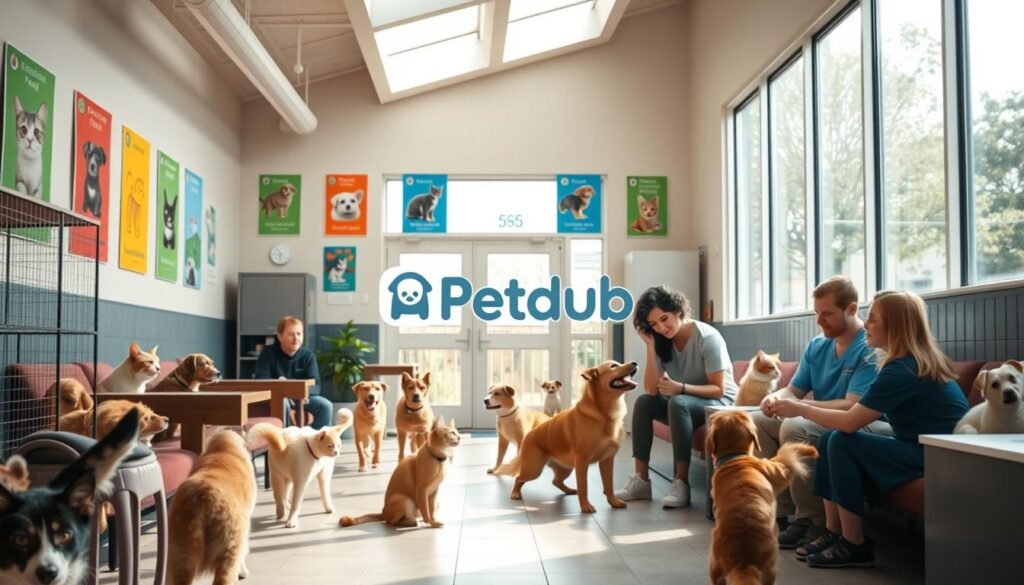Adopting a furry friend from an animal shelter is incredibly rewarding. It brings joy and companionship to our lives. But, finding the right pet can seem overwhelming, especially for first-timers. That’s why we’ve put together this guide with essential shelter pet adoption tips to help you through the shelter pet adoption process.
Our journey started at the local animal shelter. There, a shy but loving pup caught our eye. She wagged her tail with hope as we approached. It was love at first sight. We knew she was meant to be part of our family. Let’s help you find your own special shelter pet.
Key Takeaways
- Understand the importance of adopting from animal shelters and the benefits of rescuing a furry friend.
- Learn how to prepare your home and lifestyle for a new pet, ensuring a smooth transition.
- Discover tips for making an informed decision and finding the perfect match for your family.
- Explore the adoption process, from interacting with potential pets to completing the necessary paperwork.
- Gain insights on training, socializing, and caring for your newly adopted shelter pet.
Understanding the Importance of Pet Adoption
Choosing to adopt a pet from an animal shelter is a kind and impactful choice. It not only gives a loving home but also supports animal welfare groups. Let’s explore why adopting from shelters is important and the benefits of rescuing a pet.
Why Adopting from Shelters Matters
Animal shelters are vital for caring for homeless pets across the country. They offer a safe place for animals abandoned, surrendered, or rescued from neglect. By adopting from a shelter, you give a deserving pet a second chance. You also help reduce the number of animals euthanized each year.
The Benefits of Rescuing a Furry Friend
Adopting a shelter pet has many benefits. These pets are often spayed, vaccinated, and microchipped, saving you money and time. Shelters also assess pets’ temperaments to match them with the right family. Shelter pets are often very grateful, forming strong bonds with their new families.
Adopting a pet changes their life and helps animal welfare. By supporting local shelters and rescuing animals, you make a big difference. You help countless pets and support shelters in their mission to care for and find homes for all.

“Adopting a pet from a shelter is one of the most rewarding experiences you can have. It’s not just about giving a home to a deserving animal – it’s about forming a lifelong bond with a new family member.”
Preparing Your Home for a New Pet
Getting our home ready for a new pet is key. It makes sure our new friend feels safe and comfortable. This helps them adjust well and start a great relationship with us. Here are some easy steps to make your home pet-friendly.
First, make sure your home is safe for pets. Check for things like loose wires and small objects that could be harmful. Also, pick a special spot for your pet’s things like food, water, and toys.
- Identify and secure any potential hazards in your home.
- Designate a cozy and comfortable space for your pet’s essentials.
- Stock up on necessary supplies, such as food, water bowls, toys, and bedding.
Next, make your home welcoming for your new pet. Set up a cozy area with their favorite toys and a soft bed. Adding familiar smells from the shelter can also help them feel secure.
| Essential Pet Supplies | Quantity |
|---|---|
| Food and Water Bowls | 2 sets |
| Leash and Collar | 1 each |
| Toys (varied) | 3-5 |
| Bedding and Blankets | 2-3 |
| Grooming Supplies | 1 set |
Preparing your home for a new pet is a big step. It helps you start a happy and rewarding journey together. Remember, caring for a pet is a big responsibility. But with the right steps, you can create a loving home for your new friend.
“The best way to prepare your home for a new pet is to approach it with patience, care, and an understanding of your pet’s needs.”
Shelter Pet Adoption Tips: Make an Informed Decision
Adopting a pet from a shelter is a rewarding experience. It’s important to make an informed decision. By understanding your lifestyle and researching different breeds, you can find the perfect pet for your home.
Assessing Your Lifestyle and Needs
Before visiting the shelter, think about your daily routine and living situation. Consider your available time, energy level, and any pets or children you have. This will help you find the right pet for your responsible pet parenting lifestyle.
Researching Different Breeds and Mixes
Shelters have a wide variety of dogs and cats, each with unique personalities and needs. Spend time learning about different shelter pet adoption tips and breed characteristics. This will help you find a pet that fits your family’s preferences and capabilities.
“Adopting a shelter pet is not just about finding a furry friend – it’s about finding the right furry friend for your life.”
By assessing your needs and exploring options, you’ll make a great decision. You’ll welcome a new, loving companion into your home.

Visiting Animal Shelters: What to Expect
Starting your journey to adopt a pet from a shelter is exciting and fulfilling. Before you go, it’s good to know what to expect. This will help you connect with the right pet for your home.
Interacting with Potential Pets
When you get to the shelter, take your time to meet the pets. Be patient and let them get to know you. Watch how they act and react to you. This helps you understand if they’re a good match for you.
- Spend quality time with the pets, playing and petting them to get a sense of their personality.
- Observe how the pets interact with other people and animals in the shelter environment.
- Ask the shelter staff for guidance on which pets might be best suited for your home and family.
Asking the Right Questions
Choosing to adopt a pet is a big decision. It’s important to ask lots of questions. This way, you can make a choice that’s right for you.
- Inquire about the pet’s history, including any known medical or behavioral issues.
- Understand the pet’s daily routine, feeding requirements, and any special needs.
- Ask about the adoption process, fees, and any additional support the shelter provides.
- Discuss your own lifestyle and preferences to find the best match for your household.
By being open-minded and eager to learn, you can find the perfect pet for your family.

“Adopting a shelter pet is one of the most rewarding experiences you can have. It’s not just about giving an animal a loving home; it’s about gaining a loyal, loving companion for life.”
The Adoption Process: Paperwork and Fees
Adopting a shelter pet is a heartwarming and rewarding experience. But, it’s key to know the process. You’ll need to handle paperwork and fees before bringing your new pet home. This ensures a smooth transition and responsible pet care.
The adoption process begins with an application. This form asks about your living situation, lifestyle, and pet experience. It helps the shelter find the right pet for you. You’ll also need to show proof of identity, like a driver’s license.
You might also need to sign a contract. This outlines your responsibilities as the pet’s owner. It includes care, identification, and following local laws.
| Adoption Fees | Typical Range |
|---|---|
| Dogs | $150 – $500 |
| Cats | $50 – $200 |
| Small Animals (e.g., rabbits, guinea pigs) | $20 – $150 |
The adoption fees vary based on the shelter, animal’s age, and spaying/neutering status. These fees cover the initial vet visit, vaccinations, and microchipping. Knowing the costs helps prepare for pet ownership.
Understanding shelter pet adoption tips and pet ownership guidance can be challenging. But, with the right info and a responsible mindset, you’ll soon welcome a furry friend. Stay patient and committed for a lifelong bond with your new furry family member.

Introducing Your New Pet to Your Home
Bringing a new furry friend home is exciting and rewarding. But, it needs careful thought to make the transition smooth. As pet owners, we must make our home welcoming and set clear rules. This helps our pets feel safe and comfortable.
Creating a Welcoming Environment
Start by preparing a special space for your pet. This could be a cozy bed, toys, and safe areas. A warm and inviting home helps your pet bond with you and your family.
Establishing Routines and Boundaries
Consistency is crucial in pet ownership guidance. Daily routines for feeding, exercise, and playtime make your pet feel secure. Setting clear rules also ensures a peaceful home for everyone.
By following these tips, you can help your pet adjust well to your home. With patience and a focus on their well-being, you’ll build a strong bond with your new pet.

Training and Socializing Your Shelter Pet
Adopting a pet from a shelter is rewarding but needs careful pet ownership guidance and responsible pet parenting. The first step is to focus on training and socialization. This helps your pet and strengthens your bond.
Start by making a positive space for your pet. Have a routine and clear rules to make them feel safe. Use daily training to teach basic commands and good behaviors. Positive rewards help build trust and encourage good actions.
Socialization is key for your pet’s growth. Introduce them to new people, animals, and places slowly. Watch their body language to ensure they’re comfortable. This helps them become confident and adaptable, making adoption more likely. Consider training classes or playdates with other dogs.
“Proper training and socialization are essential for the well-being and happiness of your adopted pet. With patience and consistency, you can help your shelter pet thrive in their new home.”
Every pet is different, so be flexible and observant. Adapt to your pet’s unique needs and personality. With the right support, you’ll have a lifelong furry companion and a rewarding pet ownership journey.

Health Considerations for Adopted Pets
Keeping your adopted pet healthy is very important. As pet owners, we need to make sure they get regular vet visits and care. This keeps them happy and healthy.
Veterinary Check-ups and Preventative Care
Going to the vet regularly is key. It helps catch health problems early. Your vet can check your pet, give shots, and tell you how to care for them.
Preventative care is also vital. It includes stopping fleas, ticks, and heartworms. Also, make sure your pet eats well and gets dental care. This keeps them healthy and avoids expensive vet bills later.
| Preventative Care Measure | Importance |
|---|---|
| Flea and Tick Prevention | Helps protect your pet from parasites that can cause serious health issues. |
| Heartworm Prevention | Prevents the development of heartworm disease, which can be fatal if left untreated. |
| Dental Care | Maintains good oral hygiene and prevents dental disease, which can lead to other health problems. |
| Proper Nutrition | Ensures your pet receives the necessary nutrients for optimal growth and development. |
By focusing on your pet’s health, you make sure they’re comfortable and live a long life. This also strengthens your bond as you follow pet ownership guidance and responsible pet parenting.
“Preventative care is the key to a long, healthy life for your adopted pet. Regular check-ups and proactive measures can make all the difference.”
Bonding with Your New Furry Family Member
Building a strong bond with your new pet is essential for a great pet experience. As pet parents, we need to create a loving space for our pets to grow. Let’s look at ways to bond with your pet and make them feel at home.
Establish a Routine
Having a daily routine gives your pet a sense of security. It’s about setting times for meals, play, and cuddles. This makes your pet feel safe and understood.
Engage in Positive Interactions
Spending quality time with your pet through gentle petting, rewarding training, and play strengthens your bond. These moments help your pet see you as a source of comfort and joy.
Communicate with Compassion
Understanding your pet’s body language and being patient helps build trust. Listen to their cues and adjust your actions to show you care and respect.
Provide a Nurturing Environment
Creating a cozy space for your pet makes them feel at home. It’s about giving them their favorite toys and a clean, safe place. These small things help them feel secure and loved.
By following these tips, you can build a strong bond with your pet. This makes pet ownership rewarding and fulfilling. With patience, consistency, and care, your pet will thrive and become a beloved part of your life.
“The bond with a true dog is as lasting as the ties of this Earth will ever be.” – Konrad Lorenz
Responsible Pet Ownership: Commitment and Patience
Getting a pet is a rewarding experience. But, it’s a long-term commitment that needs patience and responsibility. We must be ready to give our pets the love, care, and attention they need.
Being a pet parent means understanding the good and bad of pet ownership. Taking care of a pet is a daily job. It includes feeding, grooming, training, and making sure they’re happy and healthy. We need to think about our lifestyle and make sure we can give a pet the time, resources, and energy they need before finding the right pet for our family.
Patience is very important in pet ownership guidance. Moving to a new home and routine can be hard for pets and owners. It might take some time for your pet to feel at home. But, with consistent love and care, a strong bond will grow.
- Learn about the specific needs and behaviors of the breed or mix you’re interested in adopting.
- Make a daily routine that includes playtime, exercise, and special attention.
- Be ready to invest in training and socialization to help your pet adjust to their new home.
Being a responsible pet parent is a big commitment. But, the rewards are huge. By facing the challenges and enjoying the happy moments, you’ll build a loving and fulfilling relationship with your pet.
“The greatest reward of responsible pet ownership is the unconditional love and companionship of a furry friend.”
Supporting Local Animal Shelters and Rescues
Adopting a pet is a great way to bring joy to your family. But there are many other ways to help local animal shelters and rescues. By volunteering or donating, we can help animals in need in our communities.
Volunteering and Donation Opportunities
Animal shelters and rescues need volunteers for many tasks. You can walk dogs, socialize cats, or help with office work. Fostering animals is also a great way to help them find a new home.
Donating money is another way to help. Your donations can cover vet bills, food, and supplies. Shelters also appreciate items like pet food, toys, and cleaning supplies.
- Volunteer your time by walking dogs, socializing cats, or assisting with administrative tasks
- Explore fostering opportunities to provide temporary homes for animals awaiting adoption
- Make monetary donations to help cover veterinary care, food, and other essential supplies
- Donate in-kind items like pet food, toys, and cleaning supplies
Supporting local animal shelters and rescues can change many lives. Together, we can improve animal welfare and help rescue animals in our communities.
Shelter Pet Adoption Tips: Finding Your Perfect Match
As we wrap up our guide, let’s summarize the key shelter pet adoption tips to help you find your perfect furry companion. By considering your lifestyle, researching adopting shelter dogs and adopting shelter cats, and visiting animal shelters, you’ll be well on your way to welcoming a rescue animal into your home.
Start by assessing your lifestyle and needs. Do you have the time and energy to care for a high-energy dog or a more independent cat? Consider the size of your living space and the amount of outdoor access you can provide. This will help you find the right pet that aligns with your daily routine and environment.
Next, dive into research on different breeds and mixes commonly found in shelters. This will give you a better understanding of the temperament, grooming requirements, and adaptability of potential pets. Don’t be afraid to ask the shelter staff for their expert insights and recommendations based on your preferences.
“Adopting a shelter pet is one of the most rewarding experiences you can have. Not only are you providing a loving home, but you’re also saving a life.”
When you’re ready, visit your local animal shelter or rescue organization. Take the time to interact with the animals, observing their behavior and energy levels. Ask the staff about the pets’ histories, medical needs, and any specific training or socialization they may require.
Embracing the shelter pet adoption process with an open mind and a compassionate heart will lead you to your perfect match. Be patient, flexible, and ready to welcome a furry friend into your family with open arms.
Heartwarming Pet Stories: Tales That Touch Our Hearts
Conclusion
Adopting a pet from a shelter is a rewarding and life-changing experience. By rescuing an animal in need, you give a loving home. You also help local animal shelters and promote animal welfare.
This guide has given you the tips and insights to adopt a shelter pet. It’s not just about getting a pet. It’s about changing a life and yours too.
When you start looking for your pet, be open-minded and patient. Every pet is unique. With love and commitment, you’ll form a lifelong bond. So, why wait? Begin your journey to adopt a shelter pet today and find joy in rescuing a furry friend.






